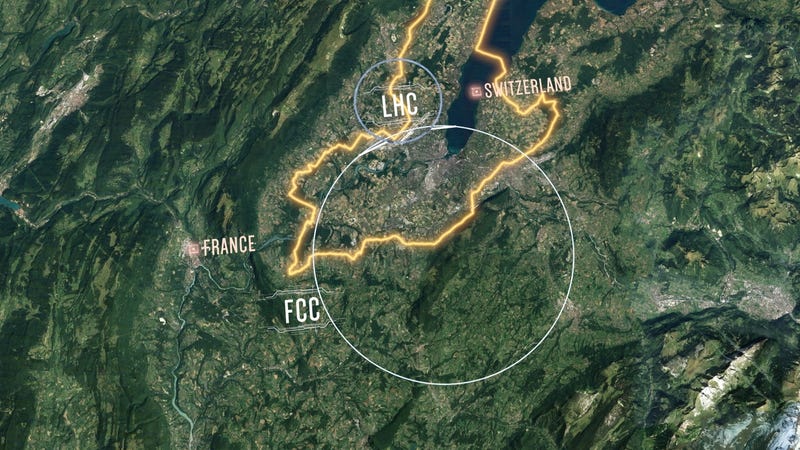
A scientific collaboration has released a concept design for the Large Hadron Collider’s successor, an enormous new experiment that would sit inside a hundred-kilometer (62-mile) tunnel.
The design concept consists of two Future Circular Colliders, the first which would begin operation perhaps in 2040. The ambitious experiments would hunt for new particles with collision energies 10 times higher than those created by the Large Hadron Collider (LHC). The concept design is the first big milestone achieved by the scientific collaboration.
“It shows the community the principles and feasibility of the post-LHC Future Circular Collider,” Michael Benedikt, CERN accelerator physicist and the study’s leader, told Gizmodo. “It shows that there is a credible, coherent physical scenario for implementing a larger-scale project that could seamlessly continue high-energy physics” once the LHC’s physics operation comes to an end in the 2030s.
Particle colliders accelerate tiny bits of matter to velocities close to the speed of light, slamming them together and observing what happens. Since energy and mass are equivalent in physics, new particles might materialize out of the collisions. High energies also allow physicists to take measurements of realms impossible to probe in a typical lab. Larger colliders typically let physicists explore the kinds of particles that filled the Universe at times closer and closer to the Big Bang.
The LHC discovered the Higgs boson, the last particle predicted by particle physics’ rulebook, the Standard Model. But there still appears to be missing mass in the Universe in the form of dark matter, and there are other unsolved physical mysteries that might require more energy than the LHC can provide—hence the need for a bigger atom smasher.
Advertisement
The FCC’s new report offers designs for a 100-kilometer-round tunnel with access points beneath and around Geneva, Switzerland, which would cost perhaps 5 billion euros (5.72 billion USD). A machine that collides electrons and their antimatter partners, positrons, would occupy the space first, then perhaps a decade or two later it would be replaced with a proton- or atom-colliding machine akin to the LHC, explained Benedikt. The LHC’s own 27-kilometer-round (16-mile) tunnel was at first home to Large Electron-Positron (LEP) collider.
Some particle physicists are enthusiastic about the possibility of discovering new physical phenomena to explain outstanding mysteries. “I’m excited because it allows us to study the Higgs boson to factors of 20 to 50 precision,” Freya Blekman, professor of particle physics at the Vrije Universiteit Brussel in Belgium and researcher at CERN, told Gizmodo. “It is the next generation of discovery machine, which [would be sensitive] to possible new particles if they exist, even if they are too massive to be made by current accelerators or only directly show up as small changes in the Standard Model.”
But there’s still some uncertainty about what the FCC will actually tell us. In her blog, Frankfurt Institute for Advanced Studies research fellow Sabine Hossenfelder wrote that “After the discovery of the Higgs-boson, there is also no good reason for why there should be something else to find, neither at the LHC nor at higher energies, not up until 15 orders of magnitude higher than what we can reach now.” In one of our Dream Experiment posts, Duke University particle physics postdoc James Beacham explained that it could require building a particle accelerator around Mars or even around the entire Solar System to actually answer physicists’ deepest question.
Advertisement
You might also note that China has released plans for its own 100-kilometer particle collider (which has its own unrelated issues). Benedikt said that these works are a confirmation that the particle physics community is interested in such an experiment.
I asked Benedikt if the group had considered some of the new research into more compact accelerators that could produce high-energy particles over a smaller footprint. He explained that these are important long-term research and development programs, but that the FCC concept proposes a facility by the end of the 2030s—essentially, there isn’t time to integrate these two technologies. Building the larger collider will rely mostly on developing more powerful superconducting magnets.
There’s a future to particle accelerators, and plenty of other experiments are underway or planned in order to probe the mysteries of the Universe. But whether the FCC will actually solve any of those mysteries is not yet clear.
Advertisement
Bagikan Berita Ini














0 Response to "CERN Unveils Design for 62-Mile-Round Atom Smasher More Powerful Than the Large Hadron Collider - Gizmodo"
Post a Comment